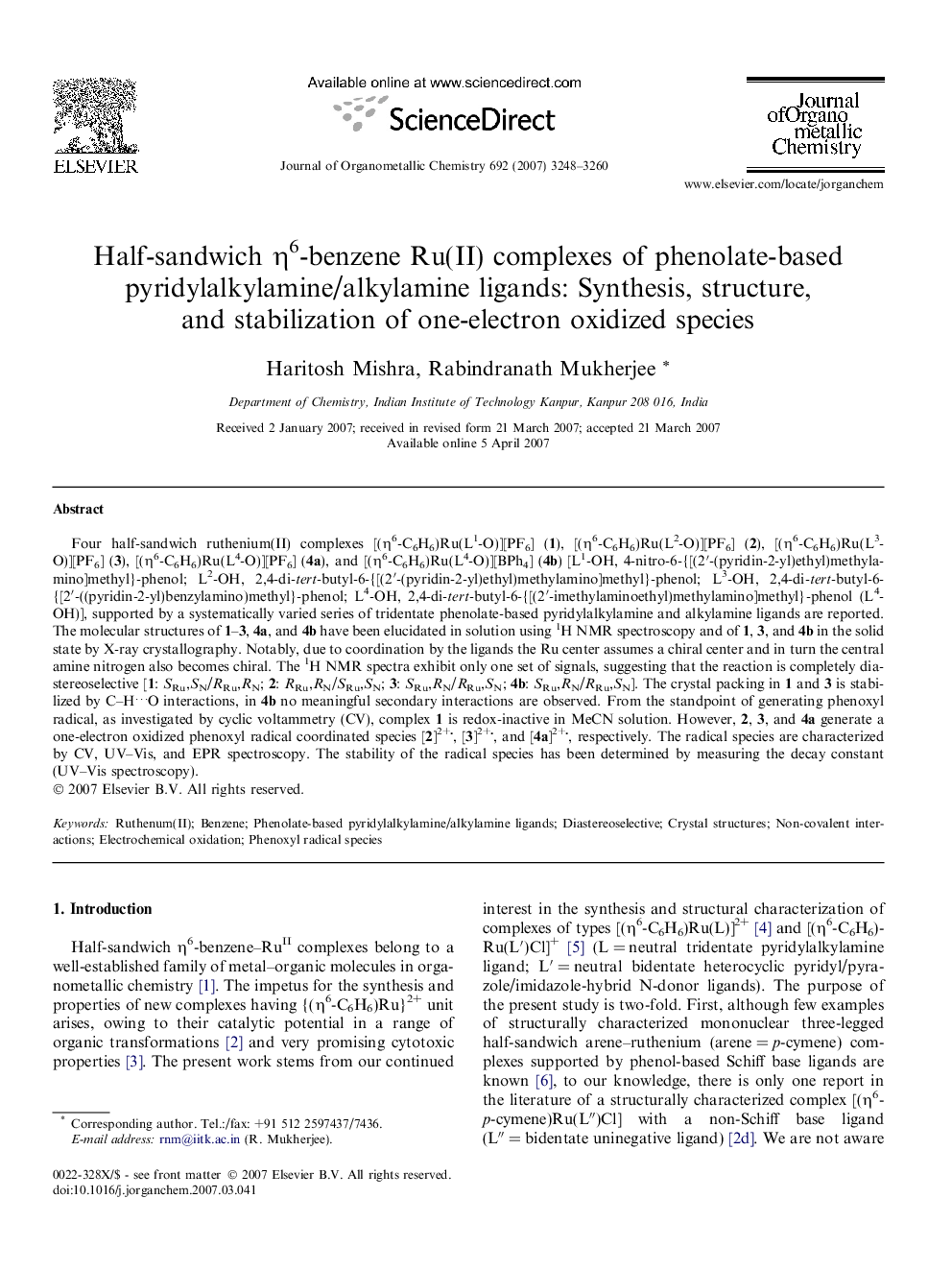| Article ID | Journal | Published Year | Pages | File Type |
|---|---|---|---|---|
| 1326752 | Journal of Organometallic Chemistry | 2007 | 13 Pages |
Four half-sandwich ruthenium(II) complexes [(η6-C6H6)Ru(L1-O)][PF6] (1), [(η6-C6H6)Ru(L2-O)][PF6] (2), [(η6-C6H6)Ru(L3-O)][PF6] (3), [(η6-C6H6)Ru(L4-O)][PF6] (4a), and [(η6-C6H6)Ru(L4-O)][BPh4] (4b) [L1-OH, 4-nitro-6-{[(2′-(pyridin-2-yl)ethyl)methylamino]methyl}-phenol; L2-OH, 2,4-di-tert-butyl-6-{[(2′-(pyridin-2-yl)ethyl)methylamino]methyl}-phenol; L3-OH, 2,4-di-tert-butyl-6-{[2′-((pyridin-2-yl)benzylamino)methyl}-phenol; L4-OH, 2,4-di-tert-butyl-6-{[(2′-imethylaminoethyl)methylamino]methyl}-phenol (L4-OH)], supported by a systematically varied series of tridentate phenolate-based pyridylalkylamine and alkylamine ligands are reported. The molecular structures of 1–3, 4a, and 4b have been elucidated in solution using 1H NMR spectroscopy and of 1, 3, and 4b in the solid state by X-ray crystallography. Notably, due to coordination by the ligands the Ru center assumes a chiral center and in turn the central amine nitrogen also becomes chiral. The 1H NMR spectra exhibit only one set of signals, suggesting that the reaction is completely diastereoselective [1: SRu,SN/RRu,RN; 2: RRu,RN/SRu,SN; 3: SRu,RN/RRu,SN; 4b: SRu,RN/RRu,SN]. The crystal packing in 1 and 3 is stabilized by C–H…O interactions, in 4b no meaningful secondary interactions are observed. From the standpoint of generating phenoxyl radical, as investigated by cyclic voltammetry (CV), complex 1 is redox-inactive in MeCN solution. However, 2, 3, and 4a generate a one-electron oxidized phenoxyl radical coordinated species [2]2+, [3]2+, and [4a]2+, respectively. The radical species are characterized by CV, UV–Vis, and EPR spectroscopy. The stability of the radical species has been determined by measuring the decay constant (UV–Vis spectroscopy).
Graphical abstractSystematic comparative studies (X-ray and 1H NMR) have been made on “piano-stool” complexes of Ru(II) with four tridentate ligands [4-nitro-6-(((2′-(pyridin-2-yl)ethyl)methylamino)methyl)-phenol, 2,4-di-tert-butyl-6-(((2′-(pyridin-2-yl) ethyl)methylamino)methyl)-phenol, 2,4-di-tert-butyl-6-((2′-(pyridin-2-yl) benzyl-amino)methyl}-phenol, and 2,4-di-tert-butyl-6-{[(2′-dimethylamino-ethyl)methylamino-methyl)-phenol]. Structural studies reveal extensive non-covalent interactions. Coulometrically one-electron oxidized RuII-coordinated phenoxyl radical species have been characterized by cyclic voltammetry, UV–Vis, and EPR spectroscopy.Figure optionsDownload full-size imageDownload as PowerPoint slide
